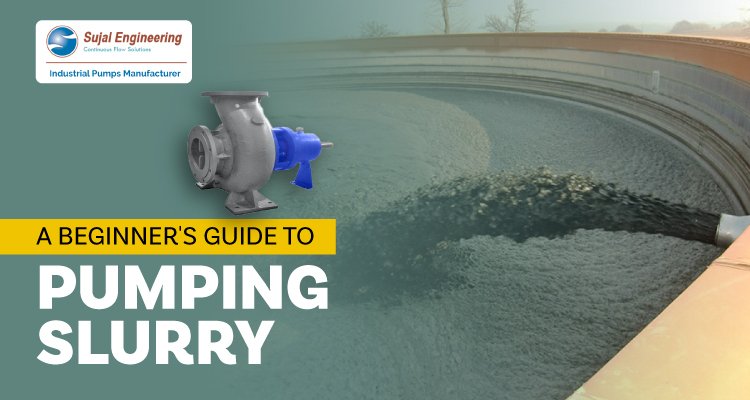A Beginner’s Guide To Pumping Slurry

The slurry is a thick, viscous, and semi-liquid mixture of a number of minerals. It is the most challenging fluid to move, made up of a high concentration of solids, very abrasive, thick, occasionally corrosive. The slurry is extremely difficult to pump, there is no doubt about that, and thus, selecting the proper pump for these abrasive applications can make a significant difference in the long-term performance of the application.
What Is Slurry?
The slurry is a fluid combination made up of a water-like liquid and suspended particles. it moves with gravity but requires pumping in most cases. Examples of slurries include cement, manure, starch, and cola suspended in water. Slurries are used as a convenient way to handle solid in mining, steel, processing, and power generation.
Types of slurries:
Non-settling Slurries
Slurries that do not settle to the bottom of the pipe include extremely small particles and may settle over an extended period of time (i.e. weeks).
Settling Slurries
Slurries that settle are created when coarse particles aggregate in an unstable combination. Coarse particles are contained in these settling slurries.
Below Are Some Common Characteristic Of Slurries
- Abrasive in nature compared to pure liquids.
- More viscous than pure liquids.
- Possibility of a high solid content (measured as a percentage of the total volume).
- When the slurry is not in motion, the solid particles often precipitate out quite fast (depending on the particle size).
- The movement of slurries requires more energy than pure liquids.
Pumps Used In The Process Of Slurry
Slurries are pumped using a variety of different types of pumps, but the most common form of pump is the centrifugal pump. Centrifugal slurry pumps work by imparting kinetic energy to the slurry via centrifugal force created by a revolving impeller, similar to how a water-like liquid would flow via a typical centrifugal pump.
The use of slurry significantly reduces the estimated life of pumping components. It is vital to pick pumps that are suited for these heavy-duty applications from the outset.
Technical Specification Of Centrifugal Slurry Pump
- Range: 3″ to 12″ (75mm to 300 mm)
- Capacity: 10,000 GPM (2257 m³/hr) \
- Heads to 240 ft (73 m)
- Pressure to: 150 psi (1,035 kPa)
Salient Features
- Made maintenance quick and easy
- Replacement of wearing parts can be done in the field
- With the two parts casing, it is possible to replace the worn front cover without changing the complete casing.
- Robust construction
- Maintenance-free
Things To Consider Before Buying A Slurry Pumps
Component
The impeller size/design, construction material, and discharge configurations must all be chosen carefully to avoid abrasive wear.
Slurry pumps often have open impellers, which are less prone to clogging. Closed impellers are the most prone to clogging and are the most difficult to clean.
Slurry impellers are huge. This prolongs their service life in slurry.
Construction
Slurry pumps are bigger than low-viscosity liquid pumps and require more horsepower to run due to their inefficiency. Bearings and shafts must also be tougher.
Slurry pumps are commonly coated with metal or rubber to protect the pump casing from wear. For example, Goulds Pumps’ XHD (Extra Heavy Duty) slurry pump is lined with rubber.
Metal casings are hard alloys. These casings are made to tolerate increased pressure and circulation.
The casings are chosen to suit the application. Pumps used in cement manufacturing, for example, handle small particles at low pressure. So a lightweight enclosure is appropriate. The pump casing and impeller need to be thicker and stronger to handle rocks.
Consideration
It’s challenging to make the slurry pumps last for a reasonable amount of time. However, there are a few things you can do to extend the life of slurry pumps.
Here are a few things to consider before buying prolonged slurry pumps:-
- Figure out where the sweet spot is that permits the pump to run at its slowest potential speed (to decrease wear) while yet moving quickly enough to prevent particles from accumulating and clogging the lines.
- Reduce the pump’s discharge pressure to the minimum.
- Apply suitable plumbing techniques to provide a consistent slurry supply to the pump.
Conclusion
Pumping slurries presents a number of difficulties, but with careful planning and the right equipment, you should be able to work worry-free for many years. Thus, it is critical to deal with a slurry pump engineer of the highest caliber.
Sujal Engineering has vast experience in industrial pumps manufacturing and develops various kinds of pumps that are best for different pumping applications. If you are looking for the best slurry pump other than any kind of pump, our pumps are the best choice for your industrial pumping needs.
Contact us by clicking here and our team with getting back to you with more information.
Read More
- Using Thermal Fluid Pumps for High-Temperature Applications
- Know and Understand Centrifugal Pumps – Pumps Manufacturer In UAE
- Centrifugal Pump For Chemical Industry – A Brief Guide
- High-Efficiency Chemical Pump For Various Chemical Applications
- 8 Benefits Of Centrifugal Chemical Pumps – An Ultimate Guide





